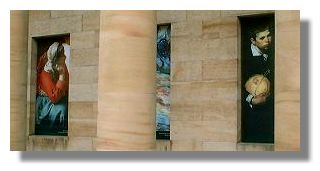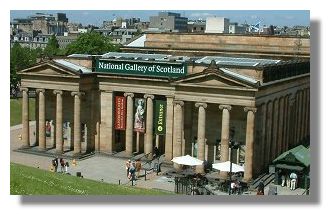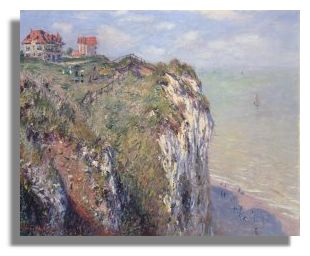And that's just a snapshot of the colourful and creative international canvas of visual arts being exhibited in galleries all over Edinburgh during the Festival 2003. Here is feature writer Vivien Devlin's introduction to what is on view.
Monet: The Seine and the Sea
Undoubtedly the artistic star of this year's Edinburgh Festival is the major international exhibition featuring 80 paintings by the French Impressionist, Claude Monet, at the Playfair Gallery, Royal Scottish Academy, The Mound, from 6 August to 26 October 2003. It focuses on an inspired and prolific period in his career, 1878-1883, when he was in his prime. This was immediately before he moved to his new home at Giverny with its water gardens and Japanese bridge, captured in his fine series of water lily paintings for which Monet is famously known. These were shown as part of the very successful Monet to Matisse 1994 exhibition at the National Gallery of Scotland and five years later, Monet at the Royal Academy in London, attracting 800,000 visitors was one of the most popular exhibitions in the world.But the Giverny paintings can be seen as the climax of decades of his experimentation in Impressionist art. It is therefore important to illustrate the broader picture and trace Monet's meticulous development as a landscape artist. His place as a true pioneer in the history of modern art is remarkable. It was Monet's painting, Impression Sunset (1873), which inspired the official name of the movement and despite many fine contemporaries, Renoir, Sisley and Pissaro, it is Monet who is considered the most consistent and representative Impressionist artist.
"Painting should simply be the expression of what I personally have felt."
Claude MonetIn Monet's Individual Style
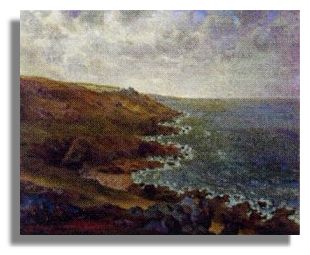
The two curators Michael Clarke, Director of the National Gallery of Scotland and Professor Richard Thomson of Edinburgh University have selected works from a short but significant period between the late 1870s and early 80s, when Monet decided to leave the competitive and critical Paris art scene behind, find fresh inspiration and concentrate on mastering his own individual style. This period was also an extremely dark and difficult time in Monet's personal life - his wife Camille was gravely ill after giving birth to their second child and they had serious financial debts.Together with his friend and patron, Ernest Hoschede, his wife Alice and their six children, Monet and his family moved 30 miles north west of Paris to the village of Vetheuil on the banks of the Seine. Here he became absorbed by the changing seasons along the river and the soft rural landscape. Later he began to visit the Normandy coast, captivated by the high cliffs, beaches and seashore - hence the title of the exhibition, The Seine and the Sea.
"We could have chosen to mount a retrospective from birth to death but this offers the viewer a more intense experience", comments Clarke. "What's clear from these painful years is that he turned away from modern life, increasingly retreating into nature."
This exhibition - which is exclusive to Edinburgh and already described as "the season's hottest ticket" - has taken a decade of academic planning and research, sourcing particular paintings from public and private collections around the world. The 80 works by Monet have been borrowed from major galleries in Paris, New York, Boston, Dallas, San Francisco, Los Angeles, Montreal, Melbourne, Berlin, Zurich, Budapest, Madrid, Lisbon - and the list goes on. In addition, to put these masterpieces in context within French landscape painting of the period, there is a small selection of paintings by a few of his contemporaries - Renoir, Corot, Courbet, Delacroix and Daubigny
The Playfair Project
What is equally important and exciting is that this Monet exhibition celebrates the opening of the Royal Scottish Academy - an elegant 19th century landmark building on Princes Street - which has been cleaned and restored as part of the £30 million Playfair Project by the National Galleries of Scotland. The RSA now provides a dedicated, state-of-the-art exhibition space for world class exhibitions such as this year's Monet: The Seine and the Sea.
A major benefactor behind the Playfair Project (named after the original architect of the gallery buildings) and the Monet exhibition - which has cost an estimated £ 850,000 to stage - is the Royal Bank of Scotland. Sir George Mathewson is its chairman:
"The Royal Bank of Scotland is proud to be sponsoring an exhibition of this stature in what is now one of the finest art galleries in the world. This promises to be one of the most popular exhibitions of the decade and we are pleased that our support has enable many of the finest paintings from this period of Monet's life to be seen by so many people throughout the UK and indeed, the world."The Paintings
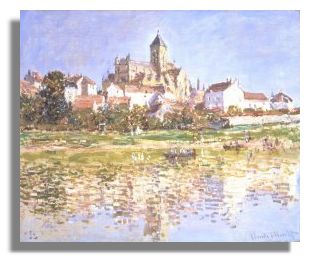
And so to the paintings themselves. In the first two years of living at Vetheuil Monet painted no less than 178 scenes of the village, mostly executed a mile or so from his home. The Church at Vetheuil, (1879), was probably painted from his studio-boat moored in mid-stream, from where he captures the reflection of church and village in the shimmering ripples of the water. This is a familiar topic, painted in summer and winter. In December 1879 bitterly cold weather caused the Seine to freeze over.
But in early January the thaw set in and his snow scenes such as The Breakup of Ice, Grey Weather are part of a series, Ice Floes, concentrating on the changing light amidst the frosty landscape, barren trees and thick ice drifting along the flooded river. His floating studio allowed him to immerse himself physically into the living heart of nature, rather than observing from the sidelines. The use of cool violet-blue, white, and grey to create a smudgy blend between the snowy ground, icy water and the heavy clouds gives a powerful poetic sense of wintry chill and quietness.
Many of these canvases of Vetheuil observed through the seasons, sold well during Monet's lifetime and are now seen as masterpieces. But perhaps this chilling mood of sadness reflected not only the weather but the artist's own feelings of despair. As the writer J. K Huysmans described their effect on him, " his blocks of ice under a reddish sky are of an intense melancholy."
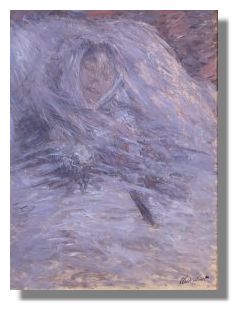
Monet's intense and committed workload at this time coincided with the grave illness of his wife (probably uterine cancer) who was failing fast after they moved to Vetheuil. His friends Ernest and Alice Hoschede - who nursed Camille and cared for the children - gave him support and companionship. With the two families struggling to make ends meet, medical bills had to be paid for with paintings so it was essential that Monet continued to work so hard. In September 1879 Camille gave up her fight to live and Monet was grief stricken yet her death gave them both an end to the pain.In quiet contemplation Monet was able to paint a final portrait of Camille on her deathbed, the pale face shrouded in a pale violet veil. As he wrote to a friend, " I caught myself watching her tragic forehead, observing the sequence of changing colours which death was imposing on her rigid face. Blue, yellow, grey and so on. .. my reflexes compelled me to take unconscious action in spite of myself."
This was a personal remembrance for his own eyes and he never sold the painting. It is now owned by the Musée d`Orsay in Paris which has always refused to lend this famous portrait to other galleries. However the concept behind this meticulously curated exhibition investigating Monet's life and work at this time, persuaded them to include Camille Monet on her Deathbed in this Edinburgh exhibition.
Monet also painted portraits of his two sons during this period Jean, now 13 years old and Michel, the baby.
A new journey of artistic discovery was then embarked upon. In contrast to the gentle rural village scenes, Monet began to make regular trips to the Normandy Coast with its high cliffs beneath which the wild waves were crashing on the beach. These seascapes such as Cliff at Dieppe (illustrated here), Cliffwalk at Pourville (1882) and Rough Sea, Etretat (1883) show stylistic maturity and a bold command of colour, capturing the changing tones of the rough sea, rocks, surf and sky.He made numerous sketches of each scene, experimenting with technique and brushstrokes, studying the effects of light from bright midday to sunset on the waves from the vantage point of the clifftop. Now his work is full of colour, sunshine and a sense of spontaneity and freedom.
Monet was reinventing himself again - not only in his approach to art but his private life was taking a turn for the better and happier. Alice Hoschede had separated from her husband and became a close companion, later his wife. In 1883 they moved to Giverny - where a fresh and very different period of his life and painting would evolve - but that is an another story.
"All my efforts are directed simply at realizing the greatest possible number of images intimately connected to unknown realities."
Claude MonetOther Art Exhibitions
There are also reviews of a selection of Other Art Exhibitions in Edinburgh during the Festival in Part 2 of this feature.
